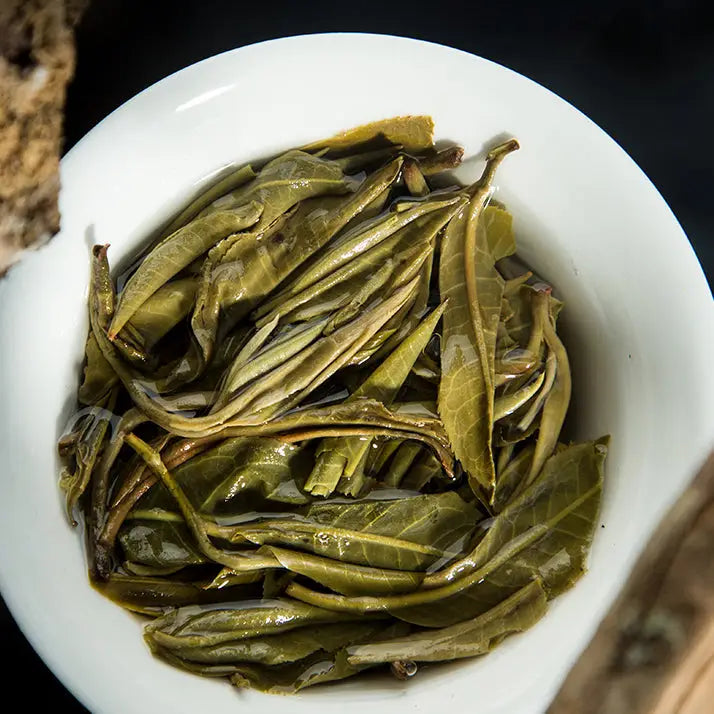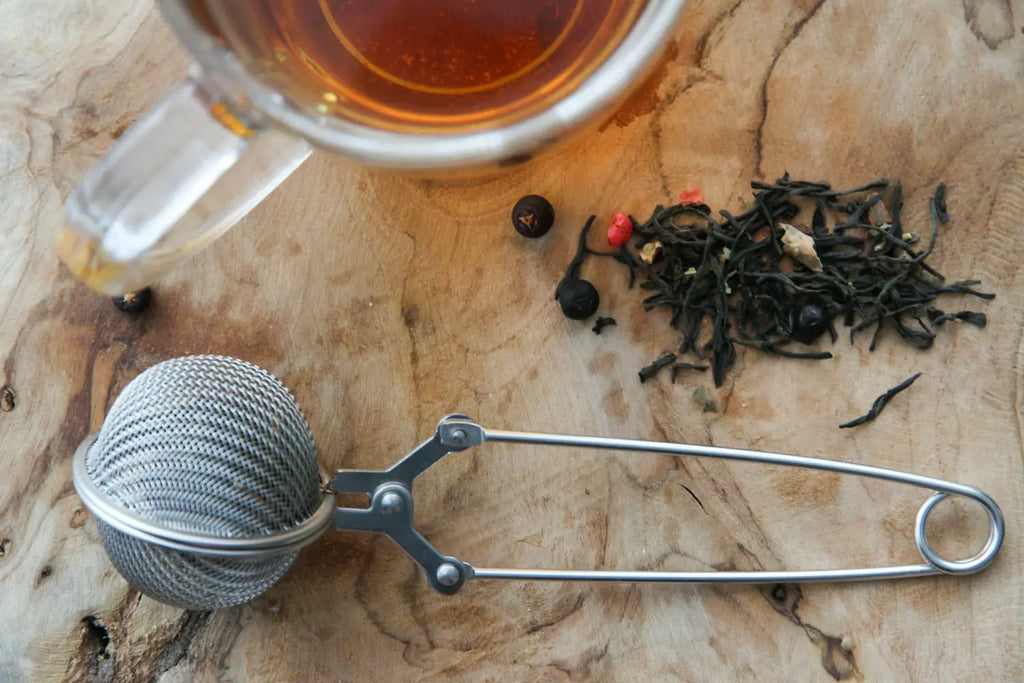How to Use a Tea Infuser
Types of Infusers:
- Mesh Ball: This classic design is easy to use. Fill with leaves, close securely, and steep.
- Silicone Infusers: Often designed with fun shapes. They are flexible and usually have tiny holes.
- Basket Infusers: These sit inside a pot or cup, allowing leaves to expand and water to circulate freely.
- Tea Sticks: Best for single servings. They stir flavor directly into the cup.
Here's how to use most infusers effectively:
Bestsellers
- Fill the infuser with the recommended amount of tea leaves. Avoid overpacking to ensure leaves can expand.
- Place it into your cup or teapot.
- Pour hot water over it, ensuring the leaves are fully submerged.
- Allow the tea to steep for the appropriate time based on the type of tea.
- Remove the infuser to avoid over-steeping.
Remember, finer mesh works well for smaller leaf teas, while larger leaves need more room to expand. Stainless steel infusers are durable, while silicone is simple to clean. Choose what suits your tea habits best.
Types of Tea Infusers

Tea infusers come in various shapes and sizes, each designed to optimize the infusion of loose-leaf teas. Choosing the right type ensures a better brewing experience and fuller flavor.
Basket Infusers
Basket infusers are designed to sit inside your cup or teapot. They typically have fine mesh, offering ample room for leaves to expand and steep fully. Baskets can be made of stainless steel or BPA-free plastics and are suitable for single cups or larger volumes of tea.
Ball Infusers
Ball infusers are metallic spheres with mesh holes that open in the middle, allowing you to fill them with tea leaves. They often come with a chain or hook to hang on the rim of your cup. These are convenient for single servings but might limit leaf expansion.
Silicone Infusers
Silicone infusers are made from food-grade silicone and come in an array of playful shapes and colors. These heat-resistant infusers are flexible and have ample holes for the tea to diffuse. Their novelty designs make them an enjoyable gift option.
Stick Infusers
Stick infusers are slender tubes with perforations, designed for stirring in cups or mugs. You fill them with tea, then steep directly in the hot water. These are particularly handy for both preparing a quick cup and enjoying delicate teas that require less steeping time.
Preparing the Tea Infuser
Proper preparation of your tea infuser ensures the best possible flavor from your tea leaves.
Selecting the Right Tea
When choosing tea for your infuser, opt for loose-leaf teas for optimal taste and infusion. Tea comes in various grades; large, whole leaves generally provide a more complex flavor profile than smaller, broken ones. Consider your flavor preference—whether black, green, white, or herbal—and select a tea that suits your taste.
Measuring the Tea Leaves
Use the following guideline to measure tea leaves for your infuser:
- Black, Green, White Teas: 1 teaspoon per 6-8 ounces of water
- Herbal Teas: 1.5 teaspoons per 6-8 ounces of water
Adjust the amount to your preference for stronger or weaker tea. Be mindful not to overfill the infuser; leaves need room to expand and release flavor.
Using the Tea Infuser
Proper usage of a tea infuser can significantly enhance your tea-drinking experience. The key steps involve heating water to the correct temperature, allowing the tea to steep for the right duration, and removing the infuser without creating a mess.
Heating the Water
To begin, fill your kettle with fresh, cold water and heat it to the appropriate temperature. Tea type dictates the water temperature:
Lao Ban Zhang
- Black tea: 200-212°F (93-100°C)
- Green tea: 175-185°F (80-85°C)
- Herbal tea: 208-212°F (98-100°C)
Use a thermometer for accuracy or a kettle with temperature settings.
Steeping the Tea
After heating the water:
- Fill your infuser: Place 1 teaspoon of loose tea per cup into the infuser.
- Place the infuser in your cup: Ensure it's secured and submerged entirely.
- Pour water over the infuser: Fill to just below the rim of your cup.
Steep times vary by tea type:
- Black tea: 3-5 minutes
- Green tea: 2-3 minutes
- Herbal tea: 4-6 minutes
Guide for your reference:
| Tea Type | Steep Time |
|---|---|
| Black | 3-5 min |
| Green | 2-3 min |
| Herbal | 4-6 min |
Set a timer for consistency.
Removing the Infuser
Once your tea is steeped:
- Lift the infuser: Allow the liquid to drain over the cup before completely removing.
- Avoid squeezing: This can release bitter flavors.
- Place on a dish: This prevents drips and spills.
Enjoy your perfectly brewed cup.
Cleaning the Tea Infuser

After enjoying your tea, it's important to clean your infuser thoroughly to prevent stains and buildup, ensuring the true flavor of your tea is preserved for your next brew.
Step-by-Step Guide:
-
Empty the Infuser:
- Immediately after use, discard used tea leaves.
- Tap the infuser gently to remove any remaining leaves.
-
Rinse with Warm Water:
- Place the infuser under warm running water.
- Use a soft brush or sponge to loosen any particles.
-
Soak if Necessary:
- For tough residue, soak the infuser in a mixture of warm water and mild detergent for a few minutes.
-
Scrubbing:
- Use a soft brush or cloth to scrub the infuser.
- Pay extra attention to mesh or holes where particles can get caught.
-
Rinse Thoroughly:
- Ensure all soap is removed by rinsing under warm water.
- Check for any remaining tea particles.
-
Air Dry:
- Place the infuser on a clean towel and allow it to air-dry completely.
Maintenance Tips:
| Frequency | Action |
|---|---|
| After Each Use | Rinse and air-dry. |
| Weekly | Soak in a vinegar solution (1 part vinegar to 2 parts water) for 30 minutes to prevent buildup, then rinse thoroughly and air-dry. |
| As Needed | If discoloration occurs, create a paste using baking soda and water. Apply to affected areas, scrub gently, rinse well, and dry. |
Proper cleaning will extend the life of your tea infuser and ensure it is ready for your next relaxing tea session.
Storing the Tea Infuser
After enjoying your cup of tea, proper storage of your tea infuser will ensure its longevity and cleanliness for future uses. Begin by rinsing your infuser under hot running water immediately after use to remove tea leaves and any residue. For a thorough clean, fill a bowl with hot water and add a few drops of mild detergent; soak the infuser for a few minutes, then rinse under running water and dry completely.
Avoid Moisture:
Ensure your infuser is completely dry before storing to prevent rust or mold growth. Stainless steel infusers, in particular, should be kept dry.
- Rack: Air-dry on a drying rack.
- Towel: Pat dry with a clean cloth.
Choose the Right Spot:
Store your infuser in a cool, dry place away from strong odors that could be absorbed by the metal.
- Cabinet: Inside a kitchen cabinet is ideal.
- Drawer: Within a dedicated tea drawer or utensil organizer.
Organize for Accessibility:
Keep your infuser where you can easily reach it:
- Stand: On a hook or stand designed for tea infusers.
- Container: In its own container or sectioned-off part of a tea box.
Use these storage techniques to maintain your tea infuser's condition, ensuring a perfect cup of tea every time. Remember, good storage habits can significantly extend the life of your tea infuser.
Troubleshooting Common Issues

When using a tea infuser, you may encounter a few common problems. Here's how to address each one efficiently.
Dealing with Residue
-
Issue: Loose tea leaves escaping the infuser.
- Fix: Ensure the infuser is properly sealed before use.
- Prevention: Choose an infuser with fine mesh or use larger leaf tea.
Managing Weak Flavor
-
Cause: Insufficient tea, too much water, or inadequate steeping time.
- Solution: Increase tea quantity, reduce water, or extend steeping.
-
Experiment: Adjust one variable at a time to find your ideal strength.
Addressing Over-Steeping
-
Problem: Tea becomes bitter.
- Immediate Solution: Remove infuser immediately to halt steeping process.
-
Future Brews:
- Timing: Set a timer to remind you when to remove the infuser.
- Tea Type Consideration: Note that green and white teas require less steeping time compared to black or herbal teas.
Frequently Asked Questions
This section covers practical guidance and solutions to common queries about using tea infusers.
What steps should be followed to properly steep loose-leaf tea in an infuser?
To steep tea properly, start by bringing fresh, cold water to a near boil. Fill your infuser with the desired amount of loose-leaf tea and place it into your cup. Pour hot water over the infuser, ensuring all leaves are submerged, and steep for the recommended time based on the type of tea.
Can you utilize tea bags within a tea infuser, and if so, how?
Yes, you can place a tea bag inside a tea infuser for a cleaner steeping process. Simply insert the tea bag into the infuser and proceed as you would with loose-leaf tea. This may also help to prevent tea leaves from escaping the bag.
How much loose leaf tea should be measured into an infuser for optimal flavor?
Generally, use 1 to 1.5 teaspoons of loose-leaf tea per 8 ounces of water. Adjust the amount based on personal taste preference and the type of tea, as some teas may expand more and require more space.
What are the best practices for using a tea infuser within a teapot?
When using a tea infuser in a teapot, make sure it fits well and is centered so that water can circulate around the leaves. Fill the infuser with loose-leaf tea, not overpacking, to allow full expansion and flavor release. Pour hot water directly over the infuser and let steep.
How do you effectively clean a tea infuser after use?
Immediately after use, discard the tea leaves and rinse the infuser under warm water. Use a soft brush or cloth to remove any residue. For deep cleaning, soak the infuser in a mixture of warm water and vinegar before rinsing thoroughly.
What is the correct method for opening and closing a tea infuser ball?
To operate a tea infuser ball, twist or pull the handle to open it. Fill one-half with loose leaf tea, avoiding overfilling. Securely close the ball so leaves can't escape during steeping. To open after use, twist or push the handle in the opposite direction.
← Older post Newer post →











